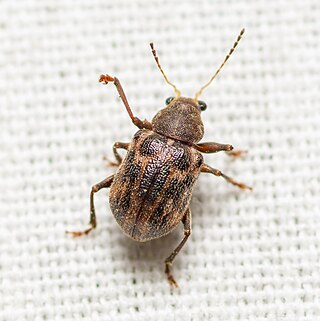
Xanthonia is a genus of leaf beetles in the subfamily Eumolpinae. It is distributed in North and Central America, and in East, Southeast and South Asia.

Doris Holmes Blake, néeDoris Mildred Holmes, was an American entomologist and scientific illustrator.

Colaspis is a genus of leaf beetles in the subfamily Eumolpinae. It is one of the largest genera in the subfamily, containing over 200 species, and it is known from both North and South America. A number of species from this genus are considered to be pests, such as the grape colaspis. Some species are known from the fossil record from the Eocene of Colorado in the United States.
Myochrous is a genus of leaf beetles in the subfamily Eumolpinae. It is known from North, Central and South America. There are over 50 described species in Myochrous. The generic name is a combination of the Ancient Greek words μῦς (mouse) and χρῶμα (color).

Metachroma is a genus of leaf beetles in the subfamily Eumolpinae. It is distributed from Ontario, Canada to Mendoza, Argentina, including the Antilles. It has also been suggested that the genus extends to the Pacific Islands, though this is not confirmed. There are about 140 described species in Metachroma, 40 of which are found north of Mexico. An extinct species is also known from the Eocene of the United States.

Eumolpini is a tribe of leaf beetles in the subfamily Eumolpinae. It is the largest tribe in the subfamily, with approximately 170 genera found worldwide. Members of the tribe almost always have a longitudinal median groove on the pygidium, which possibly helps to keep the elytra locked at rest. They also generally have a subglabrous body, as well as appendiculate pretarsal claws.

Glyptoscelis is a genus of leaf beetles in the subfamily Eumolpinae. There are 38 species of Glyptoscelis described from North, Central and South America. There are also three species of Glyptoscelis known from the West Indies, though they are wrongly placed in the genus. In addition, a single species was described from Hunan, China in 2021.

Rhabdopterus is a genus of leaf beetles in the subfamily Eumolpinae. There are about 70 described species in Rhabdopterus from North and South America, eight of which are found north of Mexico. The Nearctic species may not be congeneric with the type species, which is South American.
Graphops is a genus of leaf beetles in the subfamily Eumolpinae. There are 19 described species in Graphops, all from North America. Most species have limited flight capabilities, due to poorly developed wings, and at least one species is known to be flightless.

Typophorini is a tribe of leaf beetles in the subfamily Eumolpinae. The tribe contains approximately 100 genera, which are found worldwide. Members of the tribe are mainly characterized by notches on the tibiae of the middle and hind legs, which are sometimes referred to as antenna cleaners. They also generally have a subglabrous body, as well as bifid pretarsal claws.
Hyperaxis is a genus of leaf beetles in the subfamily Eumolpinae. It is distributed in East and Southeast Asia.

Basilepta is a genus of leaf beetles in the subfamily Eumolpinae. It is generally distributed in Asia. A single species is also known from central Africa.
Colaspina is a genus of leaf beetles in the subfamily Eumolpinae. It contains only one species, Colaspina saportae, known from Spain and southern France (Provence). The species was first described from Aix-en-Provence in 1863 by Auguste Jean François Grenier, who dedicated it to the Marquess of Saporta. It has recently been suggested that Colaspina is possibly a sister genus to both Chalcosicya and Mediterranean Colaspidea combined.
Alethaxius is a genus of leaf beetles in the subfamily Eumolpinae. It is distributed from Mexico to northern South America, and it is also found in the West Indies. The genus was originally named Aletes by Félicien Chapuis in 1874. However, this name was preoccupied by Aletes Carpenter, 1857, so the genus was renamed to Alethaxius by Édouard Lefèvre in 1885. According to Flowers (1996), it is very likely that Alethaxius is polyphyletic and represents at least three different genera.
Allocolaspis is a genus of leaf beetles in the subfamily Eumolpinae.
Exochognathus is a genus of leaf beetles in the subfamily Eumolpinae. It is endemic to Cuba, and contains only one species, Exochognathus limbatus. It was described by the American entomologist Doris Holmes Blake in 1946.
Cleoparida is a genus of leaf beetles in the subfamily Eumolpinae. It is distributed in the Solomon Islands.
Habrophora is a genus of leaf beetles in the subfamily Eumolpinae. It is distributed in Central America, South America, and the West Indies. It is placed in the tribe Habrophorini with the related genus Psathyrocerus.

Bromiini is a tribe of leaf beetles in the subfamily Eumolpinae. The tribe contains approximately 120 genera, which are found worldwide. They are generally thought to be an artificial group, often with a subcylindrical prothorax without lateral ridges and covered with setae or scales.









